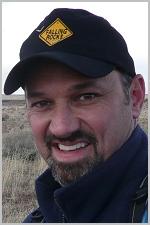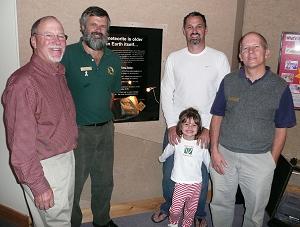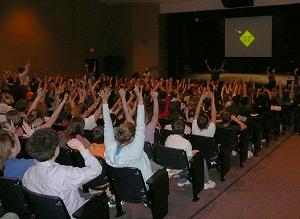Member Article - August 2008
The full version of this article is published in the August 2008 issue of METEORITE! magazine.
How YOU can make cosmic impacts of the highest order...
A gram of inspiration
 Article by Dave Gheesing |
My own formal education is a classic and, unfortunately, common example of one which for the most part was devoid of the kind of inspiration which might have triggered my greatest educational and career potential, given my innate passion for things astronomical. Though for the most part I made good marks in advanced "studies" through to my graduation from Georgia Tech - excepting a 2-year stint there as an amateur theorist studying the curve of diminishing pressures inside a keg, from which I eventually progressed somewhat - the majority of those sixteen-plus years went by with little-to-no effort expended on my studies (excepting, of course, the keg pressure studies, to which I applied great effort and from which I gleaned substantial learnings and experience).
In spite of a substantial interest in astronomy, my patience for reading and self-study was low until near the end of my college years. It is still difficult to think about those wasted years and wonder what might have been different had I taken better advantage of them, but ever since I've read virtually everything about astronomy I got my hands on - marking most books with more ink than was used to print them in the first place and constantly referring back to them and cross-referencing different resources to sharpen the finer details.
Then the tipping point came in the fall of 2000, when I was killing some time in an Atlanta science store while waiting for a friend and happened upon a 136 gram Sikhote-Alin meteorite for sale. An ACTUAL meteorite?! For SALE?! I couldn't believe my eyes, as I had until then assumed that meteorites were the provenance of scientific institutions and museums (and have since found this was once the case with most meteorite collectors). I bought the specimen immediately and quietly left the store, hoping that mall security wouldn't confiscate my package and lock me up for some federal possession violation of which I was theretofore unaware.
Better to give than to receive
 The Author with his daughter, Maddie, loaning a 43kg chondrite to Elachee Nature Science Center where almost 40,000 students a year will experience it. |
Before long, my kids would talk about them in school, and almost instantly I was in their classrooms sharing a few meteorites with their friends - always giving every student a small specimen with an identification card of their own to keep. The reaction was always, as Richard Norton best described it in one word, "electric," and kids would talk to their friends and teachers would tell other teachers and schools would tell other schools and lather, rinse, repeat. A virus was on the loose.
Then the realization first hit me: it really WASN'T so great to have that collection in my home. And I really didn't OWN these rocks anyway - most of which were older than the rock we call home - but rather was just a fortunate and temporary custodian of them in what will hopefully be a long line of custodians over many future generations.
No better time than the present
What started as an extemporaneous presentation by passing around a few meteorites and sharing all sorts of fascinating facts about meteorites with one classroom at a time quickly expanded into a formal presentation for groups of all sizes, often several hundred students at a time. All that mattered was the decision to start doing it NOW, and everything else fell into place.
|
The author giving small chondrites to a group of high school magnet students after a presentation. |
The one point I would like to make here over any other is that VERY few students and teachers know ANYTHING about meteorites so it is quite easy to develop an effective introductory presentation based on whatever your knowledge set and preferences might be. Just show up with a basic plan and you will see that the dominos start falling quite easily. I recently gave a presentation on "Meteorites 101" to a metro Atlanta county's science teacher body with my friend, Jerry Armstrong, and was both shocked and inspired by how little these science teachers knew about meteorites. The obvious implication: given the half paragraph typically dedicated to meteorites in American science textbooks, it is unlikely that the subject is reaching our students today - two centuries after L'Aigle officially launched meteoritics. Both of us, along with other fellow Meteorite Association of Georgia members Anita Westlake, David Hardy and Sean Murray, have spoken to countless Georgia students this past school year alone.
If I can do this, ANYBODY can...
 The author speaking to 400 Georgia students about meteorites. |
- Pass around some specimens (mention a little about them to get started and, of course, select them based on the size of your group and your concern for their care)
- Feature an image of Earth taken far out in space (something like the Voyager "pale blue dot" from beyond the orbit of Neptune) to demonstrate that as big as our planet is there is a LOT more out there
- Demonstrate the difference between 1,000, 1,000,000 and 1,000,000,000 by asking, then telling, them how long it would take to count to those numbers at the rate of one integer per second (you will often get the answer in seconds, but that's obviously not what you're looking for), then work your way from the Milky Way to the Hubble Deep Field to discuss how many galaxies and stars there are in the universe
- Coming back to Earth, show an image of a meteor to talk about particle sizes and velocities upon atmospheric entry (many if not most will have seen a "shooting star," but few if any will know how small the objects are that produce them and this is a great tool to demonstrate the power of cosmic velocity)
- Define the terms "meteorite" and "meteoroid" in addition to the prior discussion of "meteors"
- Talk about fireballs and show a couple of videos (this is easy to do in PowerPoint and is an absolute killer with young students)
- Discuss flight orientated meteorites, how NASA used them to sort out blunt-nosed rocket technology and atmospheric re-entry heat shields (and show visually how shapes of the same are virtually identical to oriented meteorites). Orientation is one of two great ways for young minds to grasp how violent and magical the atmospheric passage of an eventual meteorite really is
- Talk about hammers such as Peekskill, Claxton and the 3 gm Mbale stone (this is the second way for students to understand that these objects are still moving quite rapidly even after settling in at terminal velocity
- Discuss parent bodies in a "Where do meteorites come from?" section, including the asteroid belt and some good examples such as Vesta, the moon and Mars (and how we know this)
- Highlight the cosmic impact history of and current, though statistically unlikely in the near future, threat to our planet (this is a great area to show the need for future studies and solutions that could save our planet and which might come from a student in your very group)
- Cover basic composition of differentiated and undifferentiated meteorites, including things such as chondrules and CAIs, how chondrites are older than Earth itself, how slowly parent body cores have re-crystallized into Thomson Structures, how most of these features are not found in terrestrial rocks and maybe hit some interesting highlights about the contents of Murchison
- Show them what to look for if they think they have found a meteorite
- Questions & Answers (I actually take these throughout the presentation, so long as the group maintains order, raises hands, talks one at a time, etc)
- If you can, give small samples to each student along with a paper COA that tells them a little bit about it (weathered NWA chondrites are great for this purpose, and a rare earth magnet against a baggie of them is enough to spark wonder and excitement in the soon-to-be recipients)
Dave Gheesling is chairman & CEO of FEI Group (www.floorexpo.net), a co-founder and director of The Scotty Foundation (www.carecuredream.org), lives in Alpharetta, Georgia, with his wife, three kids, two dogs, three cats, and a few meteorites, some of which can be seen at www.fallingrocks.com. For questions about educational outreach efforts or whatever else he can be contacted via his Website.